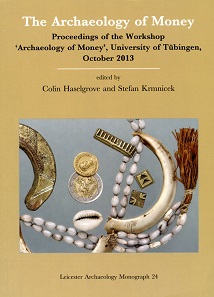by Ursula Kampmann
translated by Annika Backe
April 14, 2016 – Of course we know what “archaeology” means. The translation provided by infallible Wikipedia reads as “the study of human activity through the recovery and analysis of material culture“. But if we trace the complex meanings of the little Greek word “logos”, we soon get the idea that “archaeology” is more, and that the term may also be understood as “the doctrine of the meaning of the old”.
And this reading would very much conform to what the “Numismatische Arbeitsstelle” of the University of Tübingen did in the context of a colloquium organized by Colin Haselgrove and Stefan Krmnicek in 2013: instead of restricting itself to a single numismatic area or era, the colloquium with the title “The Archaeology of Money” rather focused on the question of what we actually know about the function of money. As a method, archaeology played a significant role indeed. Other disciplines, however, also contribute something new.
The Archaeology of Money. Proceedings of the Workshop “Archaeology of Money”, University of Tübingen, October 2013. Edited by Colin Haselgrove and Stefan Krmnicek. Leicester Archaeology Monograph 24 (2016). 238 p. with numerous illustrations and maps. 17 x 24 cm. Paperback. Adhesive binding. ISBN 978-0-9574792-3-4. 18.99 British pounds + postage.
And so this newly-released conference volume deals with more than just the question whether or not a hoard find must be interpreted as savings or sacrificial gift to the gods – although this is precisely the question that Colin Haselgrove and Leo Webley ask in their contribution on the Celtic coin finds.
At first glance, some of the topics addressed were not related to Classical numismatics at all, like the issue of when objects of value established themselves as means of barter and since when they served as standardized money.
Are the magnificent electrum rings from the second half of the 5th century BC, which are now on display in the Israel Museum, already means of payment or mere prestigious objects? In his paper, Lorenz Rahmstorf constructs the hypothesis that it was only in the Bronze Age, after scales and weight had been invented, that money in the modern sense could have come into existence. He considers this step change to be much more important for the history of mankind than the invention of the coin which only refined this concept.
Certain prestigious objects also having functioned as money nonetheless is illustrated by Scott M. Fitzpatrick by his description of the famous stone money from Yap; and Lynn H. Gamble, by example of the North American shell beads, traces back the iridescent alteration between prestigious object, means of barter and ritualistic usage. Right from the opposite side come Stephanie Wynne-Jones and Jeffrey Fleisher. Starting with the comprehensive coinage of the commercial city of Kilwa Kisiwani, off the East African coast, they work their way forward to a whole system of currency that supplemented and circulated alongside the coins.
The fact that coins do not only serve as money but can also have completely different functions is proven by Mark A. Hall in his study on the function of the coin as an amulet and a medium of faith.
A very unusual concept was presented by Jos Platenkamp, who drew on three examples from three parts of the world and three periods of time: the Northern Moluccas in the Eastern part of Indonesia (16th-20th cent.), the Inca Empire in South America (16th cent.), and the Anglo-Saxon world of the mythical hero Beowulf (7th-9th cent.). Platenkamp postulates that one aspect connects all three areas: by placing money in the soil, the “living” money becomes “dead money”, thus money which cannot be used by society anymore.
Archaeology does not stop at some point in Early History. This becomes clear by the contribution of Beverly A. Straube who, based on finds of emergency money and tokens in the Colony of Virginia, postulates that in the early 17th century the movement of goods was organized with the help of this money substitute.
It has all been seen before – that is the impression one gets when reading the contribution of Bill Maurer who relates modern cashless payment methods to the bills and receipts that have come down to us with the earliest cuneiform tablets from Mesopotamia.
You only have to flip through this volume of papers to arrive at the conclusion that money is more than coins … and coins more than money. Although “numismatics” often translates merely as “the study of coins”, we can only understand our coins when we look outside the box from time to time and explore what concepts of money were developed in the past. And sometimes this past can teach us that our modern notion of money is nothing more than tied to our period and subject to change.
You may place an order for this book online.
More information on the workshop and several images are available at the website of the Institute for Classical Archaeology of the University of Tübingen.
CoinsWeekly reported on the interesting congress.





